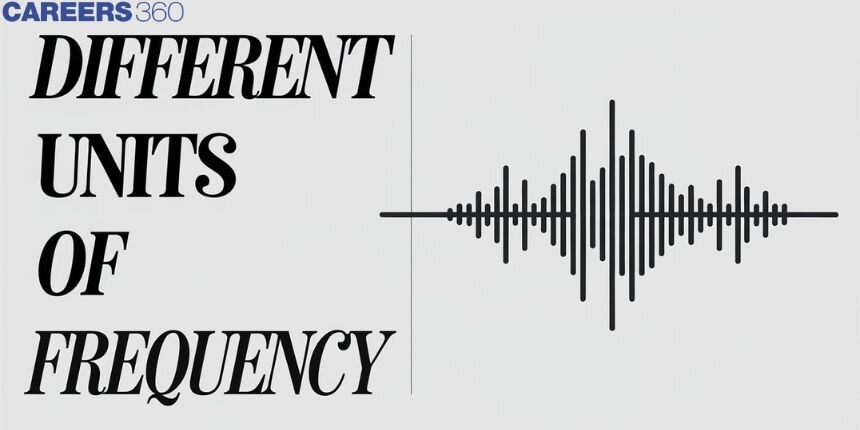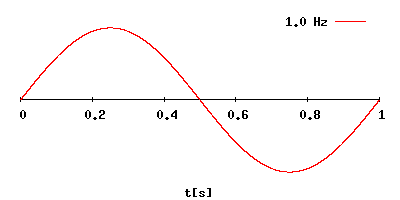Different Units of Frequency - Definition, FAQs
Frequency is known as the number of occurrences that happen in unit time. In other words, it can be described as the number of waves that pass at some point through some fixed area per unit of time. Frequency is found in many cyclic processes such as waves, oscillation, rotation and so on. The Latin letter ‘f’ is used to represent the frequency. It is also represented by the Greek symbol nu (?). In this article, let us discuss the SI unit of Frequency, its definition and uses and different expressions of units of Frequency. The SI unit of frequency is given in hertz and shortly denoted as Hz unit. The unit of frequency is given in the honor of the German Physicist and scientist Heinrich Hertz.

Definition of Hertz:
The unit of frequency of One hertz can be defined as the event that reoccurs in one unit of time. In short, it can be also described as one cycle that occurs per second. For example, let us consider the amount of frequency, 1 Hertz is the refresh rate of a picture display, then it means the picture will be refreshed once for every one second. Few other examples are 1 tick of a clock occurs at 1Hz Then The human heart can pump the blood and makes a beat at 1.2 Hertz, the moon revolves around the Earth with the frequency of more than 12 cycles per year, string of a violin might have 440 Hz of frequency i.e. 440 vibrations per second.
Hertz can be written mathematically as 1/t, where t denotes the time. The dimension of the Hertz can be given as T-1 (1/T). The Hertz can be represented in the form of the base SI unit of time, s-1 (1/s), where s denotes the second (unit of time). The plural form of Hertz is Hertz itself. So 1 hertz gives 1 cycle per unit second whereas 100 Hz gives 100 cycles per unit second.
Also read -
- NCERT Solutions for Class 11 Physics
- NCERT Solutions for Class 12 Physics
- NCERT Solutions for All Subjects
History of the unit of frequency:
Before naming the term hertz, there was a traditional unit that was used to measure the frequency, it was revolutions per minute (in short it is written as r/min or rpm). The relation between hertz and rpm can be written as one hertz = 60 rpm. The international committee for weights and measures gave the definition of second as the duration of 9192631770 periods of radiation which corresponds to the transition that occurs between two hyperfine levels of Caesium 133 atoms in their ground state. And the hyperfine splitting of the caesium 133 atom at their ground state is also given as 9192631770 Hz. In the year of 1935, The term ‘hertz’ was first officially established by the IEC (International Electrotechnical Commission). Then later in the year 1970, hertz was adopted by the CGPM (General Conference on Weights and Measures) and replaced the unit cycles per second with hertz.

Some other units of frequency:
There are some other common units used to represent the frequency. The unit of frequency also includes the following
- Time per second
- Calls per second
- Rounds per second
- Frames per second
- Beats per minute
- Zettahertz
- Exahertz 1
- Petahertz
- Terahertz
- Gigahertz
- Megahertz
- Kilohertz
Related Topics Link, |
Let us see the values of 1 kilo, mega, gigahertz and other hertz representations in the following table:
Symbol | In Hertz |
1 Hz | 1 Hz |
1 kilohertz (khz) | 1000 Hz (103 Hz) |
1 megahertz (MHz) | 1,000,000 Hz (106 Hz) |
1 gigahertz (GHz) | 1,000,000,000 Hz (109 Hz) |
1 terahertz (THz) | 1012 Hz |
1 Petahertz (PHz) | 1015 Hz |
1 Exahertz (EHz) | 1018 Hz |
1 Zettahertz (ZHz) | 1021 Hz |
Also read :
- NCERT notes Class 11 Physics Chapter 14 Oscillations
- NCERT solutions for Class 11 Physics Chapter 14 Oscillations
- NCERT Exemplar Class 11 Physics Solutions Chapter 14 Oscillations
Applications of Hertz:
- Vibrations are calculated in terms of hertz. The hearing range of infants ranges from 20 hertz to 20,000 hertz and for an adult human, the frequency of hearing differs from 20 Hz to 16,000 Hz. Also, the frequency range of ultrasound and infrasound are denoted with femto hertz and terahertz.
- Oscillations of the perpendicular electric field and magnetic field in electromagnetic radiation are measured in terms of megahertz and gigahertz.
- Radiofrequency radiation measurements are made in kilohertz, megahertz or gigahertz
- The frequency of light is measured in thousands of terahertz.
- In central processing units (CPU) of computers, the clock rate is given in the terms of megahertz or gigahertz. In the year 1970, for PC’s, the clock rate of CPUs ranged approximately 1 MHz.
In this article, we learnt the definition of frequency, SI unit of frequency, other units of frequency, the definition of hertz, expression of Hertz and application of unit of frequency. Let us discuss some more frequently asked questions about the topics frequency and SI unit of frequency in class 10, class 11, class 12.
Note: frequency kya hai means: What is frequency.
Also check-
- NCERT Exemplar Class 11th Physics Solutions
- NCERT Exemplar Class 12th Physics Solutions
- NCERT Exemplar Solutions for All Subjects
NCERT Physics Notes:
Frequently Asked Questions (FAQs)
The frequency unit is given in terms of hertz (Hz units)/hertz is the unit of frequency. Also, the frequency can be measured by using old traditional units such as rpm (revolution per minute.)
So, hertz is used to measure the frequency.
The Frequency is known as the number of occurrences that happens in unit time. hertz is the si unit of frequency/hertz si unit of frequency. hertz is a unit of the event that reoccurs in one unit of time. In short, it can be also described as one cycle that occurs per second.
Frequency unit symbol is ?.
Vibrations are calculated in terms of hertz. The hearing range of infants ranges from 20 hertz to 20,000 hertz and for an adult human, the frequency of hearing differs from 20 Hz to 16,000 Hz. Also, the frequency range of ultrasound and infrasound are denoted with femto hertz and terahertz.
Oscillations of the perpendicular electric field and magnetic field in electromagnetic radiation are measured in terms of megahertz and gigahertz.
Radiofrequency radiation measurements are made in kilohertz, megahertz or gigahertz
The frequency of light is measured in thousands of terahertz.
In central processing units (CPU) of computers, the clock rate is given in the terms of megahertz or gigahertz. In the year 1970, for PC’s, the clock rate of CPU ranges approximately 1 MHz.
Symbol | In Hertz |
1 Hz | 1 Hz |
1 kilohertz (khz) | 1000 Hz (103 Hz) |
1 megahertz (MHz) | 1,000,000 Hz (106 Hz) |
1 gigahertz (GHz) | 1,000,000,000 Hz (109 Hz) |
1 terahertz (THz) | 1012 Hz |
1 Petahertz (PHz) | 1015 Hz |
1 Exahertz (EHz) | 1018 Hz |
1 Zettahertz (ZHz) | 1021 Hz |
Hertz can be written mathematically as 1/t, where t denotes the time. The dimension of the Hertz can be given as T-1 (1/T). The Hertz can be represented in the form of the base SI unit of time, s-1 (1/s), where s denotes the second (unit of time).
Some examples are listed below:
1 tick of a clock occurs at 1 Hz,
the human heart can pump the blood and makes a beat at 1.2 Hertz,
the moon revolves around the Earth with a frequency of more than 12 cycles per year,
a string of a violin might have 440 Hz of frequency i.e. 440 vibrations per second.